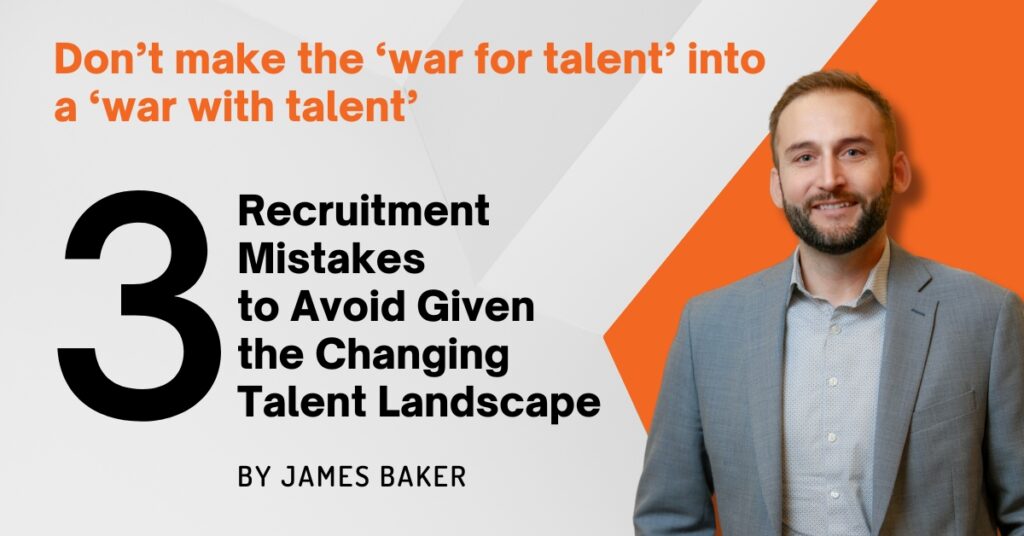Don’t make the ‘war for talent’ into a ‘war with talent’
Avoid these recruitment mistakes given the changing talent landscape – May 2023
Written by: James Baker, CEO, Keynote Search & LYNX Recruitment

If I were writing this piece three months ago, the insights would have varied quite dramatically – but such is the reality of the ever-shifting labour market. It feels as though the labour market has swung from employee-driven to much more favourable for employers, virtually overnight. And although this isn’t likely the full story, many companies are adapting their strategies; with various degrees of success.
Some key signals that indicate the market’s shift are the typical ones that we have seen during a loosening market cycle:
- Candidates aren’t negotiating compensation when considering offers, they are focused instead on termination clauses and severance
- People are making lateral moves financially or even taking pay reductions in order to maintain secure employment
- Employers have multiple candidates to pick from at the late stage of hiring processes and often have more experience and expertise than in previous quarters
- Application volumes to posted jobs have skyrocketed
- Employers are confident they can make changes to their workforce and attract alternative candidates at a fair and reasonable price point
With these in mind, here are 3 things to consider in this shifting labour market:
1. Be prepared to compromise
In a more balanced labour market, it is crucial to focus on what is fair and equitable. What are your top priorities that need to be met and where are you prepared to compromise? As an example, employers generally want their people back in the office most of the time, so compromising on three days a week may be a good place to land. Employers may be looking to reduce total cash compensation due to financial constraints but perhaps a more lucrative incentive program can be put in place so the upside is there for both employer and employee. The days of the employee making the demands and the employer saying yes rather than having options seem behind us. It’s time to get back to compromise and common sense on both sides.
2. Focus on performance and don’t get caught up in cost vs productivity
The data is clear, Canada’s workforce continues to see a plummet in productivity at a time where wage inflation is crippling many small businesses. 9 out of the last 10 quarters the market has seen workforce productivity decrease. While some would urge employers to lower salaries and put pressure on their employees to perform at higher levels, given the current deeper candidate pools – this isn’t like the answer. Just because employers have suffered doesn’t mean employees should now be adversely penalized just because the labour market is changing. Organizations have the right to expect a level of performance and output from their biggest investment – people. Focus, however, needs to be on performance management and setting clear, obtainable and deliberate goals for each and every person. Managers need to commit to actively supporting and leading their people in the pursuit of these goals and reward them appropriately. As an employer you now know you can replace underperformers, but your duty to your people is critical in ensuring they understand what success looks like and how they can accomplish it.
3. Have a team assigned to every recruitment process
Of course, I will tell you to engage a firm like Keynote Search or LYNX Recruitment for any business critical hire – we are really good at it. Because with labour costs as high as they are and economic uncertainty abound, you need to de-risk every critical hire, and firms like ours have demonstrated that not only do we have better reach and a distinct process for finding talent, but that we can also assess fit and support post-hire performance in ways most businesses simply can’t. With that said, at the very least you need to have a team assigned to every hire you make – from your most junior person to your executive leader. You will have increased interest in every role, more choices and candidates with more diverse backgrounds, experiences and education.
You will have the potential to attract people that didn’t even show up on your radar six months ago. The challenge however, is that you can get caught up in the ‘magpie effect’. The shininess and excitement of a candidate can mean you overlook the long-term fit and implications of hiring that person. What are their true motivations? Are you a stop-gap for them due to market conditions? Do they share your values? Are they driven by the same outcomes? Will they build on the cultural framework you have worked hard to establish and need to protect at all costs? Just because they can do the job, seem well-priced and have more experience than you thought you could get, doesn’t mean they are the right person for you now or for the future. Employers tend to overestimate the short-term impacts of a hire and underestimate the long-term effects. A second and even third opinion on the role, the fundamental skills required and the success factors is critical and you should be bringing those same people back for interviews to provide objective and candid reviews of potential new hires.
We are in a place where every recruitment decision needs to be centred on mutual benefit. I am genuinely worried that employers will take too much leverage back from employees and we will go from a war for talent to a war with talent. Employees and employers want the same thing – successful employment with measurable success, fair rewards and recognition. As employers, we have a responsibility to ensure we recognize the realities of the employment base while we continue to persevere through challenging financial conditions and rising costs of goods and services. Let’s not forget that our businesses exist because of our people we work with and the people we serve.

